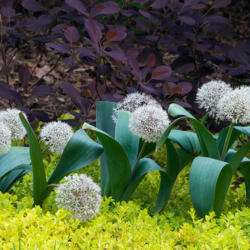I'm sorry that so many of you have had problems with Alliums. It's no secret that commercial growers cultivate Alliums in very light soil and lifts them annualy. This helps a lot in controlling diseases such as fungal rots, but if pathogens are present it may not solve all problems. Pathogens could be both in the bulbs and in the soil.
If the soil is clay consider planting in a raised bed with sandy or even gritty soil or why not in a pot that is protected from too much rain in the winter. In milder areas this could be as easy as to make a light bulb potting mix made of well draining materials such as horticultural grit, sharp sand or similar mixed with just a little compost. Then just place the pot under a roof overhang. No peat based soils please! Personally I have a lot of sand in my potting mixes for bulbs as the soil is nothing but fine sand here and I try to use what I already have, but this wont be as well draining as a bit coarser sand or grit nor will it hold as much air. Or plant bulbs close to a tree or plant them among a low growing ground cover that helps to suck excess moisture out of the soil.
Don't mulch Alliums. Last autumn I did an experiment and planted some Alliums in a semi shaded situation and mulched with some leaves. This would simulate the conditions in a well drained but more moisture retentive soil. We most often have a lot of rain during autumn/early winter, but this year was worse than most, so the soil remained fairly wet until bloom, but still had excellent drainage. I used Allium Ambassador that I previously had some problems with. I suspect that the bulbs had become infected with fusarium or similar. I also tried the white blooming Mount Everest.
Many of the Ambassador bulbs were very disappointing. Some rotted before blooming and others showed signs of rot and were discarded when dug this summer. Mount Everest on the other hand remained healthy, but almost didn't multiply, rather seemed to produce a little larger bulbs than the previous year, but still overall not a great result. So I think the soil matters here. I think that those of you that try to grow in clay soil are up to a real challenge with the more sensitive species or cultivars.
Some additional thoughts:
Whenever I've checked on an Allium bulb that tries to bloom on a very short stem it has been in the process of rotting. It has been too wet and/or attacked by some pathogen.
Also consider that some Alliums are raised from seed and produce few or no offsets so with time the old bulb will die. This is completely normal. I've read that this is the case with for instance Allium schubertii, but haven't been able to confirm it.
Perhaps obvious, but I'd also say one should start out with healthy stock and get it into the ground in time. While storage above ground for summer is healthy for many bulbs, I believe too long storage can induce rot in many species as they become weakened and too dry. Besides they need to grow roots at the proper time.
These Turkestan Onion (Allium karataviense) has grown for several years in this position. A bit more shade than ideal as seen on the elongated stems, but my belief here is that the ground cover of Lysimachia nummularia (a yellow leaved cultivar, don't know which) has helped to keep the Alliums healthy. It should be noted this allium multiply very slowly for me or not at all.
